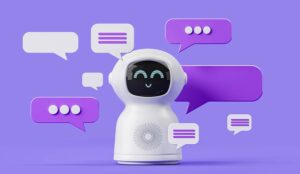Talkdesk’s Dawn Harpster looks at AI ethics and CX and explains how to build effective AI chatbots.
There will always be a need for human involvement in complicated customer experience processes, but during relatively simple and repetitive interactions, companies can lean on technologies like voicebots and chatbots to expedite customer service solutions.
That is, as long as the technology consistently provides smooth, useful experiences for customers. I recently joined Paige Lorde, an AI ethicist and TikTok influencer, for a deep dive discussion about AI chatbots, current perceptions surrounding the technology, and ethical considerations to help companies use AI chatbots well.
Read on to learn how companies can overcome resistance to chatbots, build chatbots that uphold excellent customer service, and leverage chatbots for long-term customer experience success.
Combining AI Chatbots and Human Agents to Elevate CX.
Chatbots, AI, and voicebots are quickly becoming common technology. Companies are increasingly adopting their use in today’s digitally-driven marketplace, so it’s important to learn what chatbots and voicebots can and can’t do.
There’s a common misconception that bots can do literally anything. While there are some tasks that bots are really good at, they are not yet capable of doing everything.
There will always be tasks that humans should handle with skilled customer service and empathy. Contact centre agents have highly specific domain expertise that they can use to train AI, making it faster and more responsive to customers.
We call this human-in-the-loop technology. With contact centre agents in the loop, the AI tool learns faster and ultimately performs better, a win for both customers and contact centre agents.
Let’s be real, we’ve all experienced the frustration of interacting with a badly designed bot. There are so many bad chatbots out there people have been conditioned to expect a bad experience.
The good news is that today’s technology can help prevent those bad experiences. Time, research, and best practices have been invested to transform chatbots and voicebots into useful tools that provide better CX.
Overcoming Resistance to AI Chatbots.
For those resistant to chatbots and voicebots, there’s definitely an incentive to keep an open mind. It’s well known that people have had negative experiences with bots in the past, but today, their capabilities offer clear benefits. For example, if someone can opt for self-service instead of having to wait on hold, why not try it?
There have been huge advances in how bots are made. They are great tools for triaging calls correctly, accurately collecting information so that agents don’t have to, and saving significant time for companies and their customers over the long term.
What’s more, organizations with high call volume can quickly ramp up their support if they save even one minute on every call.
These tools are providing significant value and return on investment as a sustainable solution that’s only getting better with age.
Today, companies can make significant gains using bots designed specifically for CX. These AI chatbots and voicebots incorporate CX research and voice of the customer to accelerate return on investment through conversation templates and prebuilt workflows.
In moving beyond misconceptions and resistance, it’s clear to see that the capabilities of chatbots create win-wins. As customers interact with well-designed bots, they’re more willing to use them again, and they gain trust and confidence in the tools.
Design Elements for an Effective AI Chatbot or Voicebot.
Initially, there are two factors to take into consideration when designing a chatbot or voicebot: the customer use case and the potential value for the company.
When it comes to customers, it’s crucial to consider the ways in which they will interact with the technology.
For companies, it’s important to ensure that the tool will add business value. Above all, it’s crucial to make sure that the chatbot or voicebot doesn’t require the customer to do a lot of heavy lifting.
Key considerations in chatbot and voice bot design:
Understand the Why.
First and foremost, take time to understand why the tool needs to be built and whether it is going to be voice or digital. Remember, there are things that can be done digitally that can’t be done with voice and vice versa.
With a clear understanding of the foundational elements, it’s easier to determine what the customer experience is going to be like.
Carefully consider what customer expectations might be and pay close attention to context. Taking time to truly explore how customers will use the tool gives companies a much better chance of ensuring that the tool is easy to use and that it provides a seamless experience to solve problems quickly.
Account for Timing and Backend System Performance.
Another important aspect of chatbot and voicebot design is timing. Have an understanding of which systems, APIs and databases are behind the tool, and account for any time the customer may spend waiting for the system to fetch data and return answers.
For example, if there’s a potential delay within the system that causes a gap when the customer won’t hear anything, acknowledge the delay.
Also, if the customer is asked for information that may take a minute or two to find and read, like a long account number on an insurance card, take that specific context into consideration and allow extra time so that the customer can succeed.
Create AI Chatbots that Fuel Customer Motivation.
Incentives go a long way in keeping customers motivated. Consider what would persuade a customer to engage with a chatbot or voice bot. If the tool decreases wait time, tell them.
If they can answer at any time without listening to a long list of choices, tell them. When the customer experience is easy and pleasant, they’re likely to use the tool again.
If customers tell information to a chatbot or voicebot and that information is successfully relayed to an agent, the customer gains trust and confidence in the system.
Companies should avoid the most common chatbot design flaw, which is a poorly designed menu. It’s not helpful to customers if the menu is disorganized, overwhelming, or outdated.
As always, there will be times when a customer urgently needs to speak to a human. These scenarios typically involve payments or missing packages and it’s simply best to help those customers get where they need to go immediately.
Ethical Considerations for Building Chatbots and Voicebots.
It’s wise to consider how AI-powered tools are capable of positively or negatively impacting the world. Perhaps one of the most recognizable ways people use technology and AI for negative purposes is fake emails.
They can infiltrate systems and extend further into business technologies, exposing sensitive customer data, including financial information. When it comes to chatbots and voicebot design, full disclosure to the customer is key.
There have been incredible leaps in technology and chatbots and voicebots can sound very human. If it’s not obvious, it’s important to disclose to customers that they are speaking to a bot. Lack of disclosure is an ethical breach and can cause customers to lose trust in the business and the brand.
In today’s hyper-connected world, when someone has a bad experience, they’re likely to share it with friends, family, and in online reviews.
There’s a theory that human beings react strongly to interacting with bots that seem too humanlike because it can trigger cognitive dissonance and the sensation of experiencing conflicting signals.
It’s very important to be honest and never attempt to fool customers into thinking that a voicebot is a human if it is not.
Advice for Businesses Considering Chatbots or Voicebots.
While it’s true that chatbots and voicebots have had their share of bad publicity, these tools are incredibly useful. A well-designed bot involves time and effort to help customers get to the right person the first time.
Chatbots and voicebots can prevent customers from being passed from agent to agent by collecting information to route them correctly the first time and can reduce the number of abandoned or dropped calls. And now, AI chatbots are poised to revolutionize customer service even more.
Companies that are interested in leveraging chatbots, AI, and voicebots should begin by getting to know their customers on a deeper level.
Explore the customer data that’s already available to understand why customers are calling. Determine if customers are tech-savvy, find out their demographics, and begin to think about which aspects of customer service need to be measured.
As customers become increasingly dependent on digital technologies, they’re interacting with bots more than ever.
Voicebots and chatbots play a unique role in elevating customer experience, especially through the call center, and they are highly valuable to help modern companies grow and shape the future of customer experience.
This blog post has been re-published by kind permission of Talkdesk – View the Original Article
For more information about Talkdesk - visit the Talkdesk Website
Call Centre Helper is not responsible for the content of these guest blog posts. The opinions expressed in this article are those of the author, and do not necessarily reflect those of Call Centre Helper.
Author: Talkdesk
Published On: 17th Feb 2023
Read more about - Guest Blogs, Talkdesk






 Talkdesk is a global customer experience leader for customer-obsessed companies. Our contact center solution provides a better way for businesses and customers to engage with one another.
Talkdesk is a global customer experience leader for customer-obsessed companies. Our contact center solution provides a better way for businesses and customers to engage with one another. 












